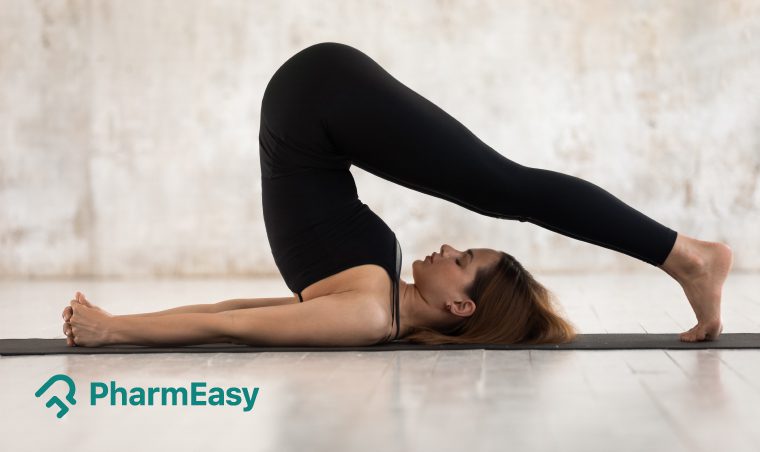Benefits of Halasana (Plough Pose) and How to Do It By Dr. Himani Bisht
By Dr. Himani Bisht +2 more

Get,

to manage your symptom
Get your,


4 Cr+ families
benefitted

OTP sent to 9988776655



You’ve successfully subscribed to receive
doctor-approved tips on
Whatsapp

Get ready to feel your best.

Hi There,
Download the PharmEasy App now!!


Register to Avail the Offer
Send OTPBy continuing, you agree with our Privacy Policy and Terms and Conditions

Hi There,
Sign up on PharmEasy now!!
Trusted by 4 crore+ families

OTP sent to 9988776655



You have unlocked 25% off on medicines




Code: NU25
By Dr. Himani Bisht +2 more
Table of Contents
In this modern sedentary lifestyle, our health has been at the receiving end of our hectic schedules! As a result, we always find ourselves experiencing physical and mental pressure. Unfortunately, this has also affected our personal habits leading to various diseases.
Fortunately, Patanjali, the ‘father of yoga,’ left us his classic work including yoga to combat all kinds of lifestyle stress. His work teaches us discipline to live a healthy life. Yoga brings a sense of freedom to life. With different types of Yogasanas; each gives you indispensable health benefits. One such Asana is Halasana! If you are living a ‘9 to 5’ office life and are looking for something to undo all the damage done with your demanding daily hustle, then you have come to the right place.

Keep reading to know everything you might need to start practising Halasana.
Did You Know?
Halasana or Plough pose is a kind of Yogasana1.
Halasana is the Sanskrit name in which Hala means plough, whereas Asana means pose or posture. Thus, it is referred to as the Plough Pose because the final position of the body appears in the shape of an Indian Plough (farming tool) while performing this Asana. Halasana may help to keep up your spine healthy and youthful1,2.
The plough tool helps to loosen soil and resurface fresh nutrients for sowing. In the same way, performing Halasana stretches the back of the body and aids in loosening the tight hamstrings, helping strengthen and re-energise the entire spine. It is said that people who perform Halasana regularly are highly active, quick, light-footed and full of spiritual energy2.
Halasana has two variations:
Based on my experience, I’ve observed that practising Halasana (Plough Pose) might help reduce constipation by increasing the movement of the intestines. The compression created during this pose stimulates the muscles and promotes better bowel motility, which can alleviate constipation and ensure a smooth digestion6.
Dr. Siddharth Gupta, B.A.M.S, M.D (Ayu)
There are two versions to do this Asana. One is Halasana, the full plough posture, and the second is Ardhahalasana, the half-plough pose1. The following steps will guide you to do both full and half plough pose:
The maximum benefits of Halasana may be achieved when you practise Bhujangasana immediately after Halasana. In Bhujangasana, you lie on your stomach and your upper body is raised upwards. The body posture looks like a snakehood2,3.
Some of the potential benefits of Halasana are:
If you are experiencing tightness in your hamstring muscles and experiencing lower back pain, then you must try the Halasana pose. The regular practising of Halasana steps allows stretching of the entire back, including the spine and hamstring. A stretching exercise like the plough pose might help loosen your tight hamstrings, providing flexibility and mobility. It also relaxes the ligaments and muscles in the calves and thighs region2.
Halasana may enhance spine flexibility. By practising Halasana, your back gets completely stretched, which energises,strengthen, and tone your spinal cord when the back is folded. It may ease up the muscle tension and keep your spine young and healthy. It might also enhance the spinal nerve functions by creating pressure on the nerve and neck region, boosting nervous system operations2,5.
The benefits of Halasana may be associated with helping in better digestive system functioning. It may relieve problems like bloating and dyspepsia, an upper abdominal discomfort caused due to stomach ulcers or acid reflux (backward flow of stomach acid into the food pipe). It may help to reduce the burning sensation, heartburn, bitter taste, etc. It may solve the problems of constipation and digestion1.
Yoga practice may help develop the mind and body; however, it is still not an alternative to modern medicines. Therefore, you must not rely on yoga alone to treat any condition. Instead, consult a qualified doctor who will be able to assess your condition correctly and advise accordingly. Furthermore, it is necessary to practice and learn yoga under the supervision of a trained professional to avoid injuries.
I have observed that practising the Plough Pose (Halasana) can provide a complete stretch to the spine and increase compression in the front of the neck and abdomen. This stretching and compression help improve the flexibility and strength of the spine, while also stimulating the abdominal organs and promoting better digestion6.
Dr. Rajeev Singh, BAMS
Also Read: Benefits of Bhramari Pranayama and How to Do it By Dr. Himani Bisht
Some contraindications and precautions related to Halasana are as follows:
With the guidance of a trained yoga expert, we can assess and analyze the risk factors and continue to practice exercise with precautions.
Also Read: Benefits of Prana Mudra and How to Do it By Dr. Himani Bisht
Halasana or plough pose is a complete Yogasana that helps one to attain spine flexibility and keep the spine youthful. Performing Halasana/Ardhahalasana might have several health benefits for the spine, hamstrings and muscle tension. It may also help with constipation, hypertension, diabetes, etc. One must practice plough pose regularly with appropriate precautions and under a trained Yoga master to avoid any physical injuries.
Also Read: Benefits of Sarvangasana (Shoulder Stand) and How to Do It By Dr. Himani Bisht
Halasana is a Sanskrit term where ‘Hala’ means plough and ‘Asana’ mean pose/posture; hence, referred to as Halasana. While performing Halasana yoga pose, our body resembles a plough shape in the final position1,2.
Ardhahalasana is a simpler version of Halasana. It is also called the half-plough pose. While performing Halasana, if you hold your legs at a 90° angle, that position is called the Ardhahalasana1.
If you have lower back pain (Lumbosacral condition), it is advised to practice Halasana with either leg and not with both legs together3. However, you may consult a professional Yoga trainer if you want to try the Asana.
Halasana is a Yogasana for back strengthening. It completely stretches the back of the body, helping the spine flexibility and rejuvenating spine health. However, performing Halasana while having a back pain problem is not recommended2.
Disclaimer: The information provided here is for educational/awareness purposes only and is not intended to be a substitute for medical treatment by a healthcare professional and should not be relied upon to diagnose or treat any medical condition. The reader should consult a registered medical practitioner to determine the appropriateness of the information and before consuming any medication. PharmEasy does not provide any guarantee or warranty (express or implied) regarding the accuracy, adequacy, completeness, legality, reliability or usefulness of the information; and disclaims any liability arising thereof.
Comments

Leave your comment...
You may also like
Comments